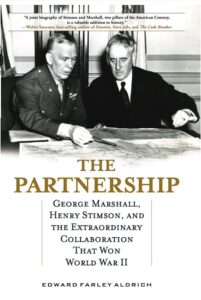 Ted Aldrich is the author of “The Partnership: George Marshall, Henry Stimson, and the Extraordinary collaboration that Won World War II.” On September 1, 1939, the day Germany invaded Poland to launch World War II, Gen. George Marshall was sworn in as chief of staff of the U.S. Army. Ten months later, Roosevelt appointed the prominent elder statesmen Henry Stimson secretary of war. For the next five years, from adjoining offices where the door between them was always left open, Marshall and Stimson headed the army machine that ground down the Axis. Their effort, one of the greatest feats of management in the history of the world, was also one of the most consequential collaborations of the twentieth century. The Partnership tells the story of how they worked together to win World War II and reshape not only the United States, but the world.
Ted Aldrich is the author of “The Partnership: George Marshall, Henry Stimson, and the Extraordinary collaboration that Won World War II.” On September 1, 1939, the day Germany invaded Poland to launch World War II, Gen. George Marshall was sworn in as chief of staff of the U.S. Army. Ten months later, Roosevelt appointed the prominent elder statesmen Henry Stimson secretary of war. For the next five years, from adjoining offices where the door between them was always left open, Marshall and Stimson headed the army machine that ground down the Axis. Their effort, one of the greatest feats of management in the history of the world, was also one of the most consequential collaborations of the twentieth century. The Partnership tells the story of how they worked together to win World War II and reshape not only the United States, but the world.
Ted is a Rowayton native and son-in-law of DMA member Pete Scull. He majored in economics and political science at Colgate University and received an MBA in finance from Boston College. He has a career in international finance, primarily in commodities, and has held senior positions at UBS, Fortis, and Mizuho Bank and is now with Auramet Trading, one of the world’s largest physical precious metals merchants. He has long had an interest in history, leading to his decision to write a book about these two key figures in World War II.
Arranged by Pete Scull
 The Partnership: George Marshall, Henry Stimson, and the Extraordinary Collaboration that Won World War II
The Partnership: George Marshall, Henry Stimson, and the Extraordinary Collaboration that Won World War II
On September 1, 1939, the day Germany invaded Poland to launch World War II, Gen. George Marshall was sworn in as chief of staff of the U.S. Army. Ten months later, Roosevelt appointed the prominent elder statesmen Henry Stimson secretary of war. For the next five years, from adjoining offices where the door between them was always left open, Marshall and Stimson headed the army machine that ground down the Axis. Their effort, one of the greatest feats of management in the history of the world, was also one of the most consequential collaborations of the twentieth century. The Partnership tells the story of how they worked together to win World War II and reshape not only the United States, but the world.
The general and the secretary traveled very different paths to power. Educated at Phillips Academy, Yale, and Harvard Law, Henry Stimson joined the Wall Street law firm of Elihu Root, a future secretary of war and state himself. He went on to serve as U.S. Attorney for his friend President Theodore Roosevelt, secretary of war under Taft, governor-general of the Philippines, and secretary of state under Hoover. A 73-year-old wise man and internationalist Republican with an excellent track record, Stimson ticked the boxes for another Roosevelt, who was in the middle of his third reelection campaign at the time. Thirteen years younger, George Marshall graduated from the Virginia Military Institute, then began a very slow, climb up the army ranks despite having a nearly flawless service record (during World War I he performed brilliant staff work for General Pershing). After a string of postings, Marshall ended up in Washington in the 1930s and impressed FDR with his honesty, securing his appointment as chief of staff.
Marshall and Stimson combined with a dazzling synergy to lead the American military effort in World War II, in roles that blended business, politics, diplomacy, and bureaucracy in addition to warfighting. They transformed an outdated, poorly equipped army into a well-equipped modern fighting force of millions. They identified soldiers and civilians, from Eisenhower, Bradley and McNair to McCloy, Lovett, Patterson, and Bundy, who were best suited for high command or sparking the industrial machine that shocked the world. They helped develop the worldwide strategy and logistical feats for battles from North Africa to D-Day. They collaborated with Allies like Churchill, Stalin, and the U.S. Navy. The two men made decisions, from the atomic bombs to the recovery of Europe, that would echo for decades. There were mistakes and disagreements, but the partnership of Marshall and Stimson was, all in all, a bravura performance, a master class in leadership and teamwork.
In the tradition of group biographies like the classic The Wise Men, The Partnership shines a spotlight on two giants, telling the fascinating stories of each man, the dramatic story of their collaboration, and the epic story of the United States in World War II.
